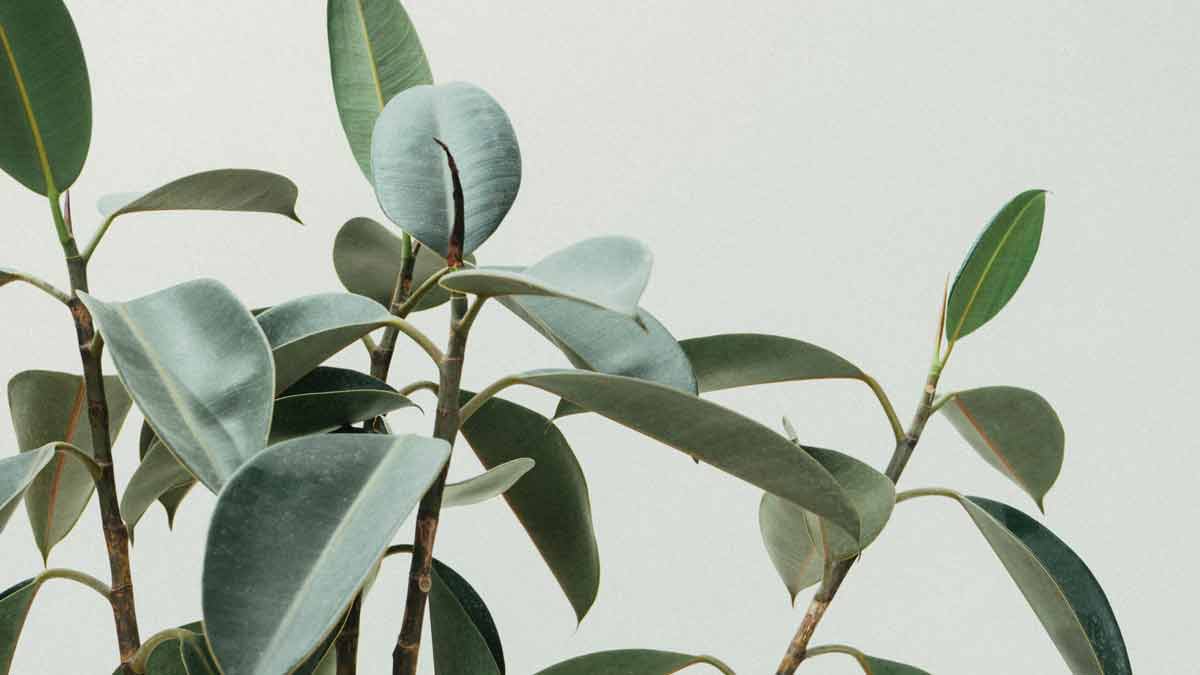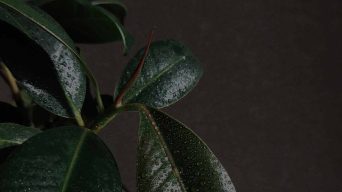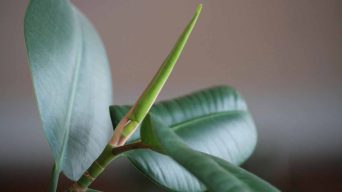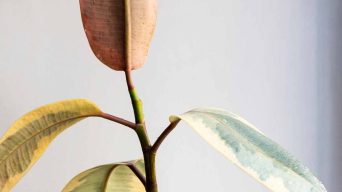An underwatered rubber plant can be identified by its yellow, dry, and wilted leaves. Brown edges and spots may also appear on the leaves, and they may droop or curl up. To revive an underwatered rubber plant, water it thoroughly and regularly to ensure it receives an ample moisture supply.
Rubber plants (Ficus elastica) can be the perfect addition to your home thanks to their impressive ability to withstand difficult conditions.
But even these resilient plants aren’t indestructible – if you’re not careful with watering, they may suffer from underwatering.
Fortunately, spotting an underwatered rubber plant is easy (hint: cue yellowed or wilted leaves), and it’s possible for them to make a speedy recovery as long as you handle them right!
Why Is Underwatering a Problem?
Underwatering can be a serious risk for your plants, resulting in wilted leaves, yellow or brown coloration, and eventual shedding of the foliage.
The vital water absorbed by the plant’s roots is needed to maintain hydration and absorb essential nutrients that help keep it healthy.
Severe underwatering of your plants can have devastating effects – stunted growth, root rot, and susceptibility to pests and diseases may result in ultimate death.
Consequently, ensuring they receive enough moisture regularly should always be a top priority!
How Does Underwatering a Rubber Plant Occur?
When caring for your rubber plant, it can be easy to forget the basics of keeping them hydrated. But underwatering is a common issue that could arise due to various reasons, such as:
Not Enough Water
Is your rubber plant not looking its best? Chances are it may be suffering from drought stress due to underwatering.
To test if this is the cause, look at the soil: if it’s dry, you need to give your Ficus elastica a thorough drink!
Signs of dehydration include wilting leaves and yellow or brown spots on foliage – but with proper hydration, these can soon return back to vibrant health.
Incorrect Potting Mix
Potting your rubber plant correctly is key to its health and growth.
The mix you choose should be well-draining to avoid waterlogging–this is when the roots sit in water for too long, which can cause rot and inhibit the absorption of essential nutrients.
Boosting drainage capabilities can be achieved by adding perlite or vermiculite into the soil blend, ultimately giving your plant an ideal environment with optimal moisture levels!
Hot, Dry Weather
Stepping outside on a hot, dry day can be uncomfortable for us and affect our rubber plants!
Whether experiencing intense summer heat or living in an arid climate year-round, take extra steps to keep your beloved plant hydrated.
Moving your rubber plant to shade and misting its leaves regularly are simple tasks that will help protect them from harsh weather conditions.
Additionally, using a humidifier around the area could provide additional protection against drying out too quickly.
Taking these proactive measures will keep you and your rubber plant happy during those harsher months of warm sunny days!
Too Much Sunlight
Sunlight is essential for a rubber plant to thrive, but too much can be damaging.
Prolonged exposure to direct sunlight may cause the soil of your rubber tree to dry out, and its leaves become scorched.
To help protect it from overexposure, move it or provide some shade in the form of sheer curtains or blinds so that just enough light reaches its foliage!
Wrong Pot Size
When caring for a rubber plant, it is important to ensure the pot size matches the root ball of your particular specimen.
If you opt for a too small pot, your rubber plant may suffer from underwatering; its shallow roots won’t be able to absorb or store enough moisture and will eventually dry out quickly.
To avoid this issue altogether and keep her happy, choose one 2-3 times larger than the diameter of her roots!
Pot-Bound
When plants are pot-bound, their roots have filled up the container and may start to grow out of the drainage holes. This can prevent your rubber plant from absorbing water and nutrients properly, causing it to dry out more quickly.
To keep this issue at bay, repot every 2-3 years using a new pot that’s just slightly larger than its root ball, with fresh soil added afterward!
Lack of Humidity
Give your rubber plant the optimal environment for a thriving life!
High humidity levels are essential to maintaining healthy growth, and if the air around it is too dry, your plant may become underwatered.
Mist the plants regularly or add moisture into the atmosphere with an indoor humidifier.
For added effect, place your pot on top of a tray filled with water and pebbles – this will allow evaporation from below, which can help retain more much-needed humidity in the air surrounding your beloved greenery.
Diseases
Diseases can be a major threat to your rubber plant’s health.
Fusarium and Pythium are fungal diseases that attack the roots, ultimately leading to drought stress caused by water not being able to take up properly when the roots rot or become infected.
To ensure your rubber plant is protected from these devastating ailments, use a sterilized potting mix for planting and clean pots for repotting. Avoid overwatering to prevent root rot related issues!
Pest Damage
Keeping an eye out for pests is key to keeping your rubber plant healthy!
Pest infestations can cause stress by sapping the sap from leaves and making it difficult for water and nutrients to be absorbed.
Be sure to thoroughly inspect your indoor plants regularly, snipping away any existing bugs before they become too much of a problem; you may even want to consider treating them with pesticide if needed.
How To Tell If Your Rubber Plant Is Underwatered
The rubber plant is an incredible houseplant – it’s hardy, easy to care for, and can bring a touch of fascinating foliage into your home. But too little water can quickly turn this beauty brown.
To ensure you keep yours looking its best, recognize the signs of underwatering so that you intervene in time!
Signs of an Underwatered Rubber Plant
Check for some common indicators if you suspect your rubber plant hasn’t received enough hydration. These may include:
Drooping Leaves
If you notice your rubber plant leaves drooping, it could be a sign of an under-watered state.
This is the most common symptom of drought stress in this type of plant – and one that can easily be rectified with some extra hydration!
Wilting Leaves
Wilting Leaves can be a sign of dehydration for your rubber plant.
Without enough water, the leaves will begin to wither and eventually turn brown due to the inability of the roots to take up moisture from their environment.
It’s important that you keep tabs on how much water is going into your plants so they stay healthy!
Yellow Leaves
If you spot yellowing leaves on your rubber plant, it’s a sign that the soil moisture is too low.
Roots need plenty of water to take up nutrients from the soil, and if this process isn’t completed successfully by roots, then plants’ leaves will start withering away.
Keep an eye out for those tell-tale hues – they could be trying to help keep your beloved houseplants healthy!
Brown Leaf Tips
Browned leaves on your rubber plant could be a sign that it’s time to water!
Without proper hydration, plants cannot absorb what they need, and the tips of their leaves will dry out.
Ensure your precious green friend is well-looked after by regularly giving them enough water – they’ll thank you later with lush foliage.
Brown Spots on Leaves
If you notice brown spots on the leaves of your rubber plant, it’s an indicator that something is amiss.
These discolored marks sign that your beloved greenery isn’t getting enough hydration to stay healthy and vibrant.
Unfortunately, when plants don’t get their fill of water, they start to dry out, meaning those stunningly lush green shades won’t last much longer!
Curling Leaves
If your rubber plant leaves start to curl, it may not receive enough water.
As a result, the shriveling leaves can turn brown and stunt normal growth – depriving them of essential moisture!
Make sure to keep an eye on your beautiful foliage and give it some much needed hydration if necessary.
Leaf Drop
Noticing your rubber plant’s leaves starting to drop? Don’t fret — it just may need a bit more water.
When the moisture intake is insufficient, plants cannot absorb adequate amounts of liquid due to their root systems not working efficiently.
This can lead your beloved leafy buddy towards a dry spell and yellowing foliage if you don’t lend it some additional hydration!
Dry and Cracked Soil
If the soil of your rubber plant is dry and cracked, it’s a sign that the plant is not getting enough water.
When a plant doesn’t get enough water, the soil will start to dry.
This happens because the plant cannot take up water properly, and the soil is not getting the moisture it needs.
Slow Growth
If you’ve noticed your rubber plant isn’t growing to its full potential, they likely need some extra hydration!
When a plant is deprived of water, its growth slows, and development becomes stunted because the dry soil makes absorbing important nutrients for continued expansion difficult.
Make sure to give them enough love with regular watering so they can grow into beautiful houseplants again.
How To Save an Underwatered Rubber Plant
A dying rubber plant due to underwatering can be saved if the problem is caught early enough.
Here are some tips on how to save an underwatered rubber plant:
1. Water the Plant Deeply and Regularly
Nourish your rubber plant with a deep, regular watering schedule.
Give it enough water until the soil is saturated and you can see water coming out of the drainage holes. Let dry before giving it more hydration again!
2. Use a Moisture Meter
Think about investing in a moisture meter to keep your rubber plant thriving!
It will provide valuable information on the perfect amount of water needed for optimal growth.
Best part? You’ll be able to tell at just one glance if you’re overwatering or underwatering – making it easier to ensure healthy and happy plants.
3. Check the Soil for Drainage
Ensure your Ficus elastica is properly cared for by testing the soil drainage!
Using a simple at-home experiment, you can check if the water in its pot drains away quickly enough.
Dig a hole and fill it with water; good drainage means all of this liquid should be gone within an hour.
4. Use a Pot with Drainage Holes
To ensure optimum growing conditions for your rubber tree, it’s essential to use a pot with drainage holes.
This will enable excess water from watering and rain to escape the soil so that its roots don’t become immersed in moisture – which can lead to root rot and other damage.
5. Move the Plant to a Humid Location
Keep your rubber plant hydrated and healthy by finding a more humid location for it to thrive.
Also, misting the leaves with water occasionally can help boost moisture levels in dryer environments.
6. Use a Humidity Tray
Keep your rubber plant happy and healthy by utilizing a humidity tray!
This easy DIY solution is created with just water filled in a tray, which you place under the potted plant.
As it evaporates, this will create an environment that retains moisture around the foliage – perfect for providing optimal conditions to keep your greenery thriving!
7. Repot the Plant in Fresh Soil
Give your rubber plant a fresh start with repotting!
Over time, soil in the same pot can become compacted and unable to hold enough water for plants’ needs.
Replacing it with new, aerated soil will encourage better root absorption and keep your plant hydrated.
How To Prevent Underwatering a Rubber Plant
Rubber plants are an easy and beautiful addition to any home but require proper care to thrive. To keep your rubber plant healthy and happy, follow these simple steps:
1. Use a Self-Watering Pot
Watering plants can be one of the most finicky aspects of gardening. Thankfully, there is an option to make this process easier – self-watering pots!
These cleverly designed containers allow you to provide your plant with just the right amount of moisture they need. A reservoir at their base ensures that water will always be available whenever your green friends need it.
2. Water the Plant in the Morning
Start your day by giving your rubber plant the drink it needs!
Give them a morning watering so their thirsty roots can take up the moisture.
Avoid evening waterings, as sitting in stagnant liquid may lead to root rot – not ideal for any greenery enthusiast!
3. Check the Soil Before Watering
Before reaching for the watering can, check your rubber tree’s soil.
A quick finger test will do: if it feels dry beneath the surface, give your plant some love with a deep watering!
4. Use a Moisture Meter
If you’re looking for an easy way to gauge when your plants need watering, then moisture meters are the perfect solution!
These convenient gadgets measure how much moisture is in a given soil – saving you from worry and guesswork.
5. Water the Plant Deeply
Give your precious plant the nourishment it needs for growth by giving its roots a deep drink of water.
Make sure you are giving enough so that moisture is seeping and saturating those hardworking roots all the way down!
6. Don’t Let the Plant Sit in Water
Don’t forget the importance of drainage for your plant – ensure any excess water from watering is drained away to prevent root rot and other hazards!
Keep an eye out on saucers or pot reservoirs collected during your self-watering routine, as they should be emptied regularly.
7. Use Mulch
Incorporating mulch into your garden can be an excellent way to promote water retention and reduce the risk of underwatering.
Be sure to choose a natural, organic option free from potentially harmful chemicals for optimal results!
8. Group Plants Together
Grouping plants together helps to create a microclimate.
The plants will help to protect each other from the wind and sun, and they will also help to retain moisture in the soil.
9. Water Early in the Day
Watering early in the day gives the plant time to take up the water before the hot sun evaporates it.
10. Use Tap Water that is at Room Temperature
Give your plants an extra layer of protection with group planting!
When combined, the plants will shield each other from wind and sunlight damage while also helping to maintain moisture levels in the soil. It’s like a mini-oasis for all your vegetation.
Final Thoughts
Caring for a rubber tree plant is easy, but neglect can cause common issues such as drooping leaves.
If you think your Ficus elastica has been neglected in watering, providing deep and regular hydration is the best way to ensure it gets back on its feet.
Allowing the top inch or so of soil to dry out between waterings should ensure your rubber plant stays hydrated properly!
It’s never too late; with proper care, you will soon see those wilted plants revived.







